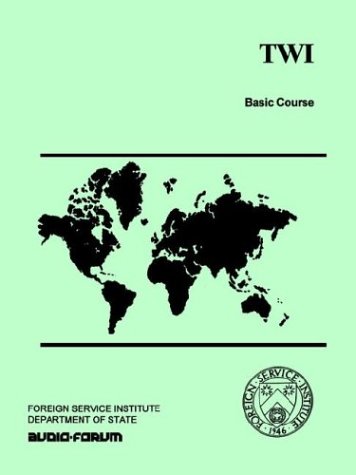Twi Basic Course

|
Author: James E. Redden Price: $ 26.90 (new) $ 15.96 (used) Medium: Paperback (224 pages) Publisher: Audio-Forum 1963-06-15 |
Editorial Description
This book is a full-length instruction course designed for both classroom use and self-study. Fifteen lessons illustrate the fundamentals of the Twi language through dialogues, vocabulary drills and grammar explanations. Using conversation as a learning tool, it details the different tonal pronunciations, inflections and the important role that they play. Cultural, history and social topics are discussed throughout each dialogue.Reader Reviews
Outstanding!This book was very helpful. It was clear and easy to follow. I feel confident that my skills in using the Twi language has improved.
 An Excellent and Very Thorough Course
An Excellent and Very Thorough CourseThe course consists of 20 units. Unit 1 introduces, in some detail, the concept of a tone language. The aim is to familiarise you with the way that words with the same spelling, when pronounced differently, have totally different meanings. 3 of the 15 tapes are for Unit 1, which consists of a series of "tone drills" where you have to identify whether the words you hear have tones that are high, mid or low, or long or short etc.
Each of the other 19 lessons is loosely based around a particular theme, e.g. meeting people; buying things; eating; asking directions; travelling; even buying petrol/getting a car repaired etc. All of the Twi in each lesson is covered on tape (each of the remaining 12 tapes containing multiple lessons). All of the lessons follow the same pattern. You start by hearing a short piece of dialogue which you learn by repetition. Then there are about 6 or 7 different "Drills". Some of these are made up of sets of questions and answers, others just statements, but they are similar in approach: typically, each "Drill" consists of a series of about 10 short sentences in Twi where each successive sentence contains some words from the previous sentence, e.g. 1) Tell him that it is here, 2) Ask him if it is here, 3) Ask him if he is gone etc. None of the English is on the tape, so you have to study this with the book in front of you, unless you are very familiar with a particular lesson.
As you progress through the course, the grammar becomes more complicated and additional vocabulary is introduced (the vocabulary is also listed separately in Twi-English, but not in English-Twi, in a 20 page glossary at the back of the book). So, for instance, the future tense is introduced in lesson 4, perfect tense in lesson 9, and in each lesson you build on what you learned in the earlier ones. Grammatical points (and a few cultural ones) are set out at the end of each chapter. I find the grammar teaching very helpful because you feel that you are beginning to understand how the language works, rather than just learning phrases by repetition.
Now here's the warning: you have to be REALLY serious and committed to make buying this worthwhile. In no way is this a criticism of Twi Basic Course, but for the following reasons it would be easy to decide to give up. Firstly, the speaker on the tapes goes at something approaching normal talking speed - frighteningly fast (especially the first few times you hear it). Each lesson lasts about 20 minutes, but I usually spend an hour at first, constantly having to rewind and replay phrases. Secondly, the words in the text are marked with symbols indicating their pronunciation - after a while you realise how useful this is, but at first it looks confusing. Thirdly, lesson 1 (tone drills) is longer than the others, is tedious and feels too abstract. I find it useful to go back to it occasionally and use it as a check now that I know some of the language. Lastly, the grammar points are quite technical and, although there is good illustration by example, it tests my (admittedly not glowing) knowledge of English grammar to its limits. (How often do you consider that the verb "to go" is an auxiliary verb?)
It's very easy to become despondent during the first couple of lessons. The good news is that it does get better, albeit slowly, and that you are learning the building blocks of the language rather than remembering selected phrases in isolation.
I wouldn't recommend buying the book without the tapes, because if you speak enough Twi that you don't need the tapes, then I don't think you'll need the book either. That said, a separate copy of the book is useful because, although the text is identical, at 22 X 14 cms, it is half the size of the version that comes with the tapes, the binding is more durable, and therefore it is more suitable for reading on the train etc.
Finally, you should know that this course covers ASHANTI Twi. Some differences are noted between the Ashanti and Akuapim dialects. The book also points out that within Ashanti Twi itself there are regional differences among the speakers. This may all be very depressing, but I will say that the Ghanaians that I know (most of whom are Ga and speak Twi as a third or fourth language) tell me that, provided I don't get something just plain wrong, they have no trouble in understanding my Twi. Perhaps the greatest endorsement of Twi Basic Course comes from Auntie Maanaa from Accra who told me simply: "You know too much!" High praise indeed.
Best of luck if you decide to go for it. It is a beautiful language.
